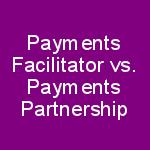 SaaS companies that offer payment processing solutions must decide whether of not become a Payment Facilitator or engaging in a Payments Partnership is the most viable solution for their business.
Neither option is “better” per se, the pros and cons of each must be weighed against your expectations for your business. First, we must understand what it means to become a Payment Facilitator (PayFac) or to engage in a Payments Partnership.Becoming a PAYMENT FACILITATOR
Payment Facilitation is in essence becoming a “master merchant” for your “sub merchant” clients. Becoming a PayFac offers the SaaS application the ability to control the end customer’s payment experience, and customers can apply and be approved and be processing in 15 minutes. Examples of big name PayFacs include PayPal and Square.
In this scenario, you are in charge of funding, acting as the primary support for payment questions. You are essentially becoming a payments company in addition to providing your SaaS solution. This responsibility makes it necessary for a significant amount of vetting done on your company in order to mitigate potential risk of the back end processor. Integration could r
Significant monetary burdens coupled with the high risk potential means that becoming a true Payment Facilitator is only the right fit for a business making significant revenue that has a large pre existing client base (e.g. hundreds of sub-merchants doing significant aggregate payment volume).
Within the PayFac model, there exists a hybrid model called Managed Payment Facilitator, which allows the advantages of instant boarding without the significant expense / integration time frame as well as speed of integration.
In this model there are two major downsides:
SaaS companies that offer payment processing solutions must decide whether of not become a Payment Facilitator or engaging in a Payments Partnership is the most viable solution for their business.
Neither option is “better” per se, the pros and cons of each must be weighed against your expectations for your business. First, we must understand what it means to become a Payment Facilitator (PayFac) or to engage in a Payments Partnership.Becoming a PAYMENT FACILITATOR
Payment Facilitation is in essence becoming a “master merchant” for your “sub merchant” clients. Becoming a PayFac offers the SaaS application the ability to control the end customer’s payment experience, and customers can apply and be approved and be processing in 15 minutes. Examples of big name PayFacs include PayPal and Square.
In this scenario, you are in charge of funding, acting as the primary support for payment questions. You are essentially becoming a payments company in addition to providing your SaaS solution. This responsibility makes it necessary for a significant amount of vetting done on your company in order to mitigate potential risk of the back end processor. Integration could r
Significant monetary burdens coupled with the high risk potential means that becoming a true Payment Facilitator is only the right fit for a business making significant revenue that has a large pre existing client base (e.g. hundreds of sub-merchants doing significant aggregate payment volume).
Within the PayFac model, there exists a hybrid model called Managed Payment Facilitator, which allows the advantages of instant boarding without the significant expense / integration time frame as well as speed of integration.
In this model there are two major downsides:
- Your revenue generation potential may be reduced though in some cases it can be equal or greater. Revenue potential is directly relatedto risk exposure.
- As a true PayFac if your SaaS client is “ABC Dance Studio” the studio’s customer would see “ABC Dance Studio]” on their credit card or bank statement. As a Managed Payfac you in essence are a sub PayFac so if your Payfac partner was PSG Payments the dance studio customer could see “PSG* ABC Dance Studio]” on their descriptor.




